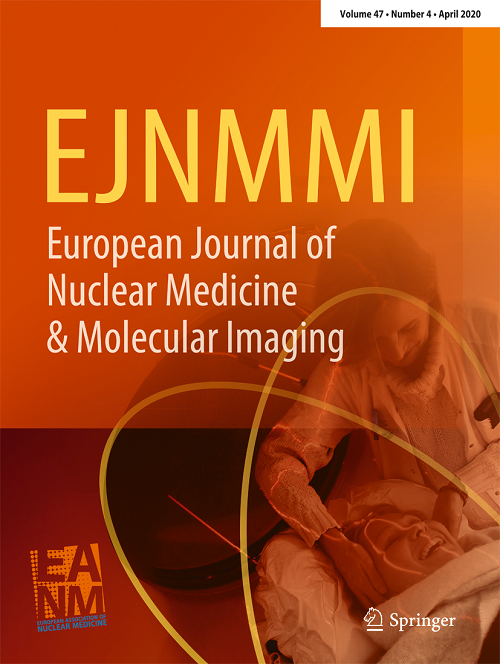系列[⁶⁸Ga]Ga- fapi -04 PET/CT在乳腺癌新辅助化疗病理反应预测及疗效评价中的价值
IF 8.6
1区 医学
Q1 RADIOLOGY, NUCLEAR MEDICINE & MEDICAL IMAGING
European Journal of Nuclear Medicine and Molecular Imaging
Pub Date : 2025-07-12
DOI:10.1007/s00259-025-07444-3
引用次数: 0
摘要
目的探讨系列[⁶⁸Ga]Ga- fapi -04 PET/CT在乳腺癌新辅助化疗(NAC)患者病理反应预测及疗效评价中的临床应用价值。方法回顾性分析64例活检证实的BC患者。序列[68Ga]Ga-FAPI-04 PET/CT扫描在三个时间点进行:NAC术前(基线,PET1)、NAC两周期后(中期,PET2)和手术前(术前,PET3)。记录NAC前后原发性BC病变的PET/CT参数。比较病理完全缓解(pCR)组和非pCR组这些参数的变化。采用Logistic回归评估[68Ga]Ga-FAPI-04 PET/CT参数对pCR预测的预测价值。采用受试者工作特征(ROC)曲线分析确定预测pCR的最佳截止值。采用DeLong检验对ROC曲线下面积(AUC)的差异进行统计学评价。结果所有患者[68Ga]Ga-FAPI-04 PET/CT参数(ΔSUVmax, ΔSUVmean, ΔFTV, ΔTLF)均显著降低,pCR组降低幅度明显大于非pCR组(P < 0.05)。结论本研究表明[68Ga]Ga-FAPI-04系列PET/CT有助于早期预测乳腺癌新辅助化疗的病理反应,评估治疗效果。需要更大样本的前瞻性研究。本文章由计算机程序翻译,如有差异,请以英文原文为准。
The value of serial [⁶⁸Ga]Ga-FAPI-04 PET/CT in predicting pathological response and evaluating therapeutic efficacy to neoadjuvant chemotherapy in breast cancer.
OBJECTIVE
To investigate the clinical utility of serial [⁶⁸Ga]Ga-FAPI-04 PET/CT for predicting pathological response and evaluating therapeutic efficacy in breast cancer (BC) patients receiving neoadjuvant chemotherapy (NAC).
METHODS
A total of 64 biopsy-confirmed patients with BC were retrospectively included. Serial [68Ga]Ga-FAPI-04 PET/CT scans were conducted at three time points: prior to NAC (baseline, PET1), after two cycles of NAC (interim, PET2), and before surgery (pre-surgery, PET3). PET/CT parameters derived from the primary BC lesions were recorded before and after NAC. The changes in these parameters were compared between the pathological complete response (pCR) and the non-pCR group. Logistic regression was used to assess the predictive value of [68Ga]Ga-FAPI-04 PET/CT parameters for predicting pCR. Receiver operating characteristic (ROC) curve analysis was employed to determine the optimal cutoff values for predicting pCR. DeLong's test was applied to statistically assess differences in the area under the ROC curves (AUC).
RESULTS
Significant reductions in [68Ga]Ga-FAPI-04 PET/CT parameters (ΔSUVmax, ΔSUVmean, ΔFTV, ΔTLF) were observed among all patients, with significantly greater decreases in the pCR group compared to the non-pCR group (all P < 0.001). In the non-pCR group, the total FTV (ΔtFTV1-2 and ΔtFTV1-3) of primary breast lesions and metastatic lymph nodes showed moderate correlation with the residual cancer burden (RCB) score. Multivariate logistic regression identified ΔSUVmean1-2 (P = 0.027), ΔFTV1-2 (P = 0.006), ΔSUVmean1-3 (P = 0.032), and ΔFTV1-3 (P = 0.010) as independent predictors for predicting pCR. On the basis of the ROC curve analysis, ΔSUVmean1-3 (AUC = 0.848) and ΔFTV1-3 (AUC = 0.906) showed slightly higher predictive performance than ΔSUVmean1-2 (AUC = 0.825) and ΔFTV1-2 (AUC = 0.869), respectively, but the difference was not statistically significant (P > 0.05).
CONCLUSION
This study demonstrates that serial [68Ga]Ga-FAPI-04 PET/CT facilitates early prediction of pathological response to neoadjuvant chemotherapy in breast cancer, as well as assessment of therapeutic efficacy. Prospective studies with larger samples are needed.
求助全文
通过发布文献求助,成功后即可免费获取论文全文。
去求助
来源期刊
CiteScore
15.60
自引率
9.90%
发文量
392
审稿时长
3 months
期刊介绍:
The European Journal of Nuclear Medicine and Molecular Imaging serves as a platform for the exchange of clinical and scientific information within nuclear medicine and related professions. It welcomes international submissions from professionals involved in the functional, metabolic, and molecular investigation of diseases. The journal's coverage spans physics, dosimetry, radiation biology, radiochemistry, and pharmacy, providing high-quality peer review by experts in the field. Known for highly cited and downloaded articles, it ensures global visibility for research work and is part of the EJNMMI journal family.

 求助内容:
求助内容: 应助结果提醒方式:
应助结果提醒方式:


